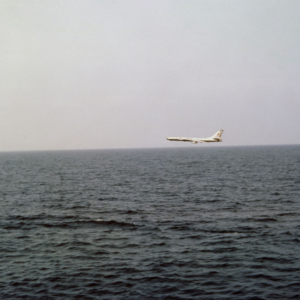The Legend of Mercedes 700K: After Hitler’s Demise, Mercedes Had to Test and Confirm It Directly!
The Mercedes 700K limousine associated with Hitler had a sad fate after its owner committed suicide.
MERCEDES 700 – A CLASSY CAR FOR THE ELITE
Mercedes is still associated with luxury and class to this day. This has always been true in the past.
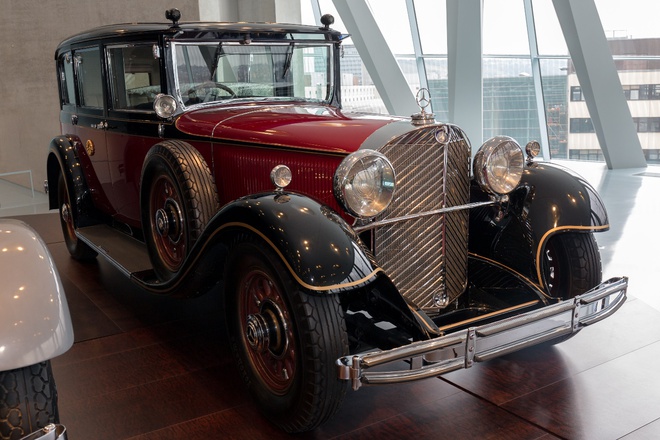
1935 Mercedes 700 (W07) of Emperor Hirohito. Photo: Morio/CC BY-SA 3.0
Mercedes manufactured the limousine coded W07, also known as Mercedes 700, between 1930 and 1938, targeting heads of state as well as the wealthy and powerful elite of that time.
Notable names using this model include Paul v. Hindenburg – former German president before and after Hitler came to power, Emperor Hirohito – on the same side as the Axis with Nazi Germany.
1938 Mercedes 700 (W150) Pullman hardtop version
After a long period of nearly a decade, Mercedes decided to improve this model and named it W150, production took place from 1938 to 1943. Still carrying a large engine, which is a 7.7-liter inline 8-cylinder turbocharged engine.
This “giant” engine block has the option of combining with an air intake to produce up to 200 horsepower. This power is transmitted to the wheels through a 5-speed gearbox system, helping to move the car weighing more than 2 tons, nearly 6 meters long to 100km/h in 17 seconds with a maximum speed of about 170km/h.
When equipped with this turbocharged engine, the car was called the 700K, because the letter “K” stands for Kompressor in German, which means supercharged in English.
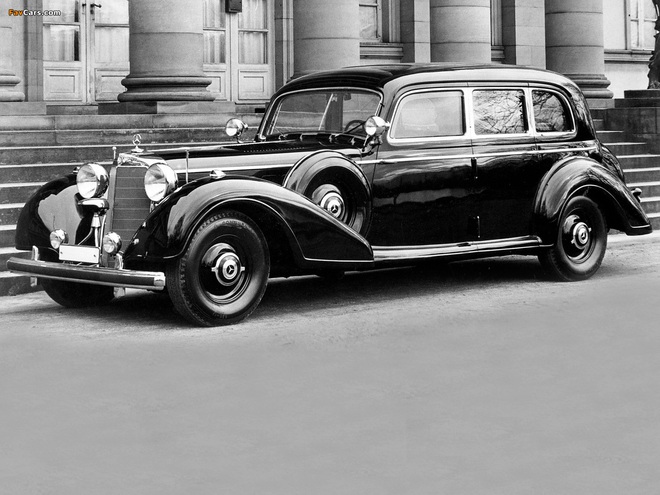
Interior of the 1938 Mercedes 700 (W150) Pullman hardtop
Besides these “mechanical” numbers, the luxury of the car also comes from its imposing design, shown in the large, vertical grille, which is very suitable for the “dinosaur” size of this car, which is about 6 meters long.
The exterior also impresses with its “flowing” design, which is considered ahead of its time. The interior with wood and leather details further enhances the luxury of the car.
With these “super” equipment, it is understandable that the car is worth as much as a house.
The Mercedes 700K (W150) Grosser Offener Tourenwagen is lucky to still exist. Photo: Canalblog
Information on the Daimler website said that the armored Mercedes W150 variant also appeared with the windshield now replaced with multi-layer glass with a thickness of 40mm, the car floor was equipped with bulletproof metal plates up to 8.8mm thick while the body and roof were equipped with 3.3mm thick steel plates.
With this bulletproof equipment, the car “gained weight” to more than 4.5 tons. If equipped with the above supercharged engine, the maximum speed would have been reduced to about 80km/h – a pretty good number at that time.
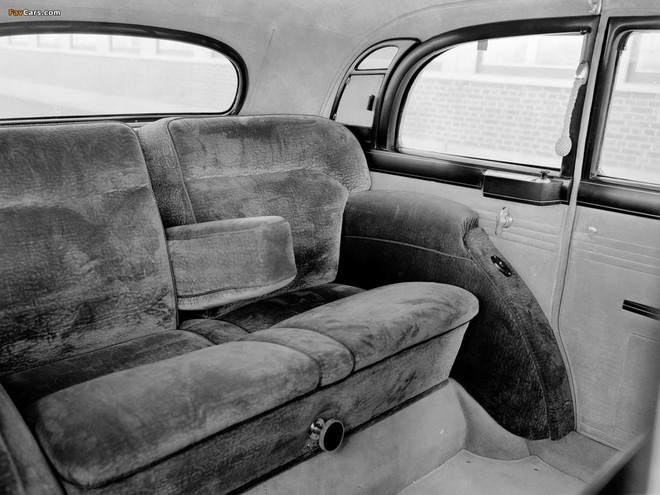
The 1936 Citroen Traction Avant in Vietnam. Photo: cafeauto
At the end of 1930 (pre-war), luxury cars also appeared with the Rolls Royce Phantom III or Citroen Traction Avant. However, the choice of the heads of state was tilted towards Mercedes when the war broke out again near the end of 1939.
That is why orders for heads of state were put on the priority list, and only a few Mercedes W150s were delivered to civilians.
The Mercedes 700K Grosser Offener Tourenwagen that served Hitler. Photo: Worldwide Auctioneers
According to some sources, during its life, Mercedes delivered 88 Mercedes 700 Grossers to customers. Currently, only about 5 remain, of which 3 are privately owned.
The car that Hitler used was one of these 3 privately owned cars, with the full name Mercedes 700K Grosser Offener Tourenwagen (Mercedes 700K ‘Grand Open Touring Car’).
MERCEDES 700K AND THE GLORIOUS PAST
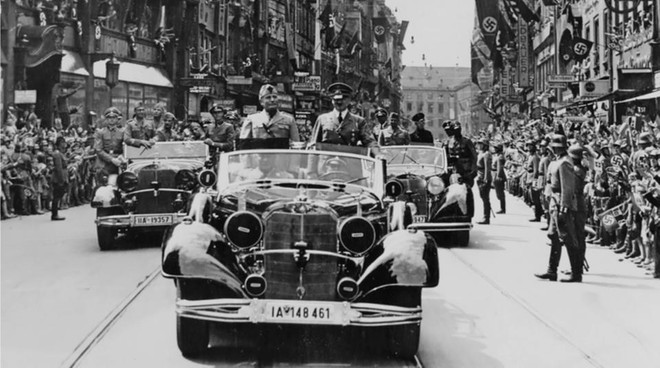
Hitler standing in a Mercedes 700K with the license plate IA 148 461
Looking back at Hitler’s documents during parades, one can see the large open-top Mercedes with the license plate “IA 148 461”, which often accompanied Hitler in such important events.
Hitler stood inside the car, his arms raised in a fascist salute in response to the similar salutes of the German people present at the event.
According to information from a document from September 1938, there is a request to produce a Mercedes 700K for Hitler by Hitler’s close driver, officer Enrich Kempka of the Schutzstaffel force (also known as the SS or Black Shirts).
It is not surprising that this car had “ultimate” requirements to maximize Hitler’s protection. Interestingly, these requirements were partly imposed by the driver Kempka, perhaps because he knew the weaknesses of an open-top car.
Photograph of Hitler’s grand parade
Other documents record the requirements of the car: 30mm thick multi-layered bulletproof windshield, removable body panels, additional protection when the windows are lowered.
The body and undercarriage were reinforced with bulletproof metal plates, a height-adjustable rear bulletproof shield, a passenger seat and a rear partition.
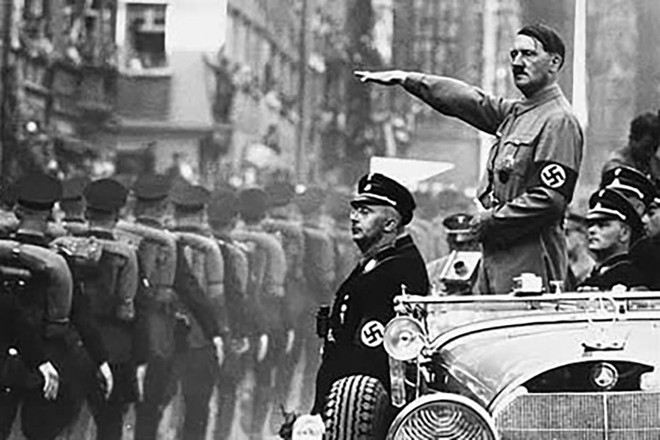
The car even had a secret compartment inside, which could have held a few Luger pistols.
A look at the back of Hitler’s car. Photo: Worldwide Auctioneers
Mercedes’ archives reveal that the car was delivered to Berlin on July 29, 1939. Shortly after, on October 6, 1939, the car made its official appearance in a grand parade. However, Hitler did not appear in the car at this time.
Hitler’s first appearance in the car was in a parade on June 18, 1940 in Munich, Germany, when Benito Mussolini – the leader of the fascist-allied dictator of Italy – made a state visit.
Hitler and Mussolini ride in a Mercedes 700K on the streets of Munich, Germany. Photo: German Federal Archive
The car then appeared with Hitler repeatedly in other important events, for example in the parade on 6 July 1940 when Nazi Germany defeated France.
The last documented appearance of Hitler with the car was in the parade on 4 May 1941 when Nazi Germany defeated Greece and Yugoslavia. It can be seen that the Mercedes 700K Grosser Offener Tourrenwagen was associated with Hitler’s image when it always appeared in the most important and major events.
THE TRAGIC FATE OF THE MERCEDES 700K AFTER THE WAR
Coincidentally, the victory of Nazi Germany over Greece and Yugoslavia was one of Hitler’s last victories. Not long after that, Nazi Germany suffered consecutive defeats after attacking the Soviet Union. The US bombing campaign severely damaged infrastructure, especially roads, in Germany.
The Mercedes factory was one of the Allies’ top targets and was frequently bombed, causing enormous damage.
The devastated scene in Dresden, Germany after being hit by a “rain” of bombs. Photo: Bettmann Archive/Getty Images
Because of these terrible attacks, Hitler’s grand parades gradually decreased, especially in the second half of World War II.
The defeat was clear. Some documents recorded that Hitler committed suicide by shooting himself after receiving continuous news of defeat, but this is still controversial information to this day.
Americans (Allied side) after the news of Hitler’s suicide. Photo: AP Photo
After the war, the US confiscated the car and handed it over to the U.S. Military Police stationed in Le Havre, northern France. The car’s fate after this time is recorded in two letters dated October 17, 1977 and November 4, 1978.
The letter was written by US veteran Duane Briggs, who served in the car squad in Le Havre, France around 1945, after he saw the car in the Houston Post in 1977.
From the letter: “…immediately recognized the car as having appeared for about 3 or 4 months in the car squad in Le Havre, France. I also drove the car myself for a few kilometers…”.
The 1978 letter also mentioned that an army colonel tried to bring the car to the US in 1945.
Photo: Worldwide Auctioneers
The car eventually made it to the US around 1946 and belonged to Mr. Vander Elst, the owner of a tobacco company.
Not long after, the car was sold by Mr. Vander and passed through many other hands; it was even mistakenly believed to belong to the Black Shirt general Henrim Himmler.
However, when comparing the information with information from the Mercedes factory, they discovered that this was actually Hitler’s car. Immediately after this discovery, the car attracted a lot of media attention, consuming a lot of ink from famous newspapers and radio stations at that time.
The Mercedes 700K when still serving Hitler
However, the fate of the car was not yet peaceful when it continued to be bought and sold several times before it was rumored to have fallen into the hands of an anonymous Russian billionaire in 2009.
At this point, the image and information about the car were cut off. No one knows the real information about the car after this time.
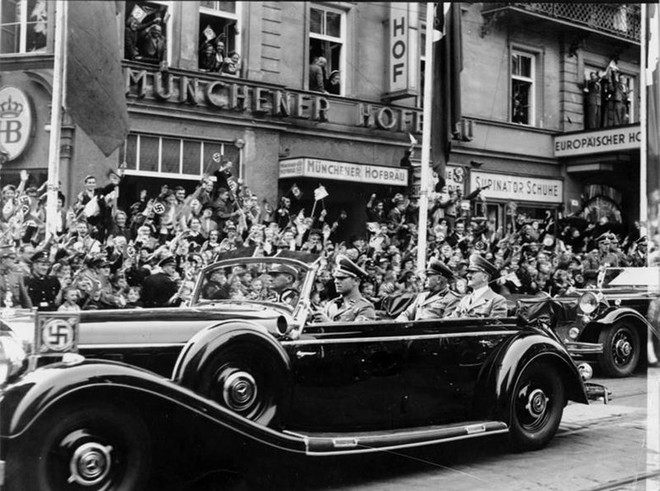
Image at the 2018 auction. Photo: Michael Chow/The Republic
Nearly a decade later, the media had another chance to get their hands on the car when it was put up for auction in the US in early 2018. The seller’s information was kept secret and the minimum bid was not announced.
Although the highest bid was around $7 million, the auction house announced that the bid had not reached the minimum and canceled the auction.
It is rumored that the seller was the Russian billionaire of the past, and he had a secret exchange with the highest bidder. Perhaps the car was sold.
The car was spotted in Seattle, USA in 2018. Photo: Jessi Sites
Shortly after that, people saw a Mercedes 700K with license plate IA 148 461 being lowered from a truck in Seattle, USA.
The information that was received said that the car was transported to a very far away place, not staying in the US.
The person who discovered the car in Seattle had a question, that is why the car did not go to the port of Los Angeles about 650km from the auction site but to the port of Seattle more than 2250km away?
The answer to this question is perhaps as mysterious as the car’s current fate: no one knows.
News
How Hezbollah & Israel counter-attack after the Lebanon Explosion
How Hezbollah & Israel counter-attack after the Lebanon Explosion This is how Hezbollah responded to Israel after the sophisticated pager and walkie-talkie explosions, which occurred across Lebanon. They retaliated by launching guided missiles for the first time. The three strikes…
[MUST WATCH] In pictures: The deadliest day in Lebanon in nearly a year of conflict
In pictures: Israel strikes hundreds of Hezbollah targets in Lebanon Israel attacked hundreds of Hezbollah targets on Monday in airstrikes, making it the deadliest day in Lebanon in nearly a year of conflict. Smoke billows over southern Lebanon following Israeli…
BREAKING NEWS: US sends more troops to Middle East as violence rises between Israel and Hezbollah
US sends more troops to Middle East as violence rises between Israel and Hezbollah Violence between Israel and Hezbollah is raising risk of a greater regional war. WASHINGTON — The U.S. is sending a small number of additional troops to the…
Easy Company Facts Even Hardcore Fans of ‘Band of Brothers’ Don’t Know
Photo Credit: HBO / Getty Images HBO’s 2001 miniseries, Band of Brothers, has continued to gain popularity in the decades since its release. This is partly due to later generations having greater access to the series – in particular, via…
Mighty MO – USS Missouri (BB-63) Video and Photos
There are three other ships in the United States Navy which were named after the state of Missouri besides the battleship USS Missouri (BB 63), and although she became associated with the history of the Japanese raid at Pearl Harbor, she…
A Soviet TU-16 medium jet bomber flies past the anti-submarine warfare support aircraft carrier USS Essex
That Time A Soviet Tu-16 Badger Crashed Into The Sea After Buzzing A U.S. Aircraft Carrier A screenshot from the video filmed aboard USS Essex shows the Tu-16 Badger flying very low close to the aircraft carrier. Low pass with…
End of content
No more pages to load





